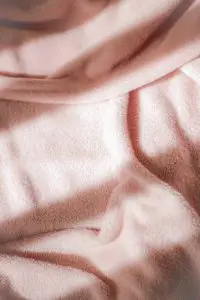Most people’s wardrobe consists of t-shirts, breathable shorts, sundresses, and comfy pants. However, most people can’t distinguish the material used in manufacturing their garments, especially rayon and cotton. If you’re also wondering, then this rayon vs cotton comparison is just for you.
The main distinction between rayon and cotton is that cotton is entirely natural, while rayon is semi-synthetic. Additionally, rayon drapes well and features a silky feel, while cotton offers users a unique softness and breathability feature. However, both materials are great for making summer clothes like shirts and sundresses.
This article will dive deep into the world of cotton and rayon to explain the key differences and similarities between the two materials. You’ll also learn what they are and how they stack up to each other when compared. So without further ado, let’s begin.
Rayon vs Cotton – What is Rayon?
Rayon was first discovered in the late 1800s as a silk substitute. It comes from processed cellulose which comes from bamboo or wood. Some people know it as semi-synthetic or a regenerative material because although it starts with a natural material, it undergoes significant chemical processing. This process usually alters its physical state.
It can be difficult to believe that wood pulp is silky and soft. This is because most rayon fabrics look and feel like silk. You’ll notice it drapes elegantly around you for wearers of rayon and usually feels smooth against your skin. The question does become if it is of good quality. The answer to this depends extensively on the top qualities you’ll like to see in fabric. This rayon vs cotton comparison touches on different features and how cotton and rayon compare.
Rayon vs Cotton – What is Cotton
Cotton usually comes from the cotton plant. It is a wooly fiber grown inside cotton balls. These balls usually go through many processes and treatments to become threads. Cotton has been around for centuries, with its origin traced back to India. However, it became pretty popular worldwide after its discovery because of its strength and softness.
During the industrial revolution, Britain took over from India as the leading cotton producer. The new technologies used by factories made it easier to mass-produce fabric for the first time since its discovery. Finally, however, America took over when an American inventor developed a mechanical cotton gin that easily separated seeds from the fluff.
This invention significantly reduced production time. Many people would argue that the demand for cotton played a role in enslaving people in America and several British-governed areas worldwide. You can recognize cotton through its softness and breathability. This fabric also offers moisture-wicking qualities, which is vital in hot temperatures.
Rayon vs Cotton – Learning the Differences
As you know now, the main difference between cotton and rayon is their processing method. While rayon is half synthetic, cotton is entirely natural. However, you might be wondering if this means one fabric is more comfortable and durable than the other. Keep reading this rayon vs cotton comparison to learn about their primary features and how they compare.
Strength
Cotton is generally stronger than rayon. However, many factors can affect the strength of the two fabrics. Rayon and cotton offer you ample strength when used for everyday wear like dresses and t-shirts. However, there’s a need to consider the strength of these materials on a long-term basis. Rayon offers excellent tensile strength when it is dry. Therefore, it is used industrially for many fabrics. However, when rayon gets wet, it has lower strength to offer. This means that rayon can easily shrink, warp, tear or stretch when it comes in contact with moisture.
On the other hand, the strength of cotton varies according to the use, quality, and length of its apparel. Therefore, utilizing top-quality cotton-like Pima cotton will offer you much higher strength than low-quality cotton or a cotton blend.
Durability
Another category in this rayon vs cotton comparison that we believe cotton wins easily is durability. Rayon loses its strength when it’s wet, making cotton a more durable option. You can use rayon in upholstery fabric. However, it doesn’t still offer you the same strength as cotton. When exposed repeatedly to sunlight, rayon is quite vulnerable and tends to fade. Rayon also has many more weaknesses beyond water. Mildew and ironing can also significantly affect your rayon apparel. With so many weaknesses, rayon is not the most durable option available. However, most people wear it for its looks, softness, and feel, not its durability.
On the other hand, most people wear cotton for its durability and comfortable fit. It is also quite attractive to wear. Cotton fiber can handle more wear and tear than rayon can, making it a durable and long-lasting option. This explains why rayon is a more affordable option than cotton. However, while offering your durability, cotton also feels great against the skin. Its rigid cellular structure allows it to withstand years of use without falling apart.
Softness
Cotton is often praised for its softness as a prominent fabric feature. On the other hand, rayon has a shiny and silky surface which feels great on the skin. However, it still doesn’t offer the same level of softness you get from natural fabric like cotton. Cotton is so soft because of its soft, absorbent fiber. It also offers a high thread count and final staples, significantly affecting its softness. The quality of the cotton used also determines how soft it feels against the skin. Top-quality cotton will feel softer when compared to the average upland cotton.
On the other hand, rayon usually feels softer than synthetic materials like polyester. This is because it is half-synthetic and still features natural fiber. As a result, it offers a lightweight texture and smooth surface, which allows it to drape effortlessly like silk. Overall, cotton wins in softness because rayon can never offer you the natural softness of cotton because of its chemically altered fibers.
Elasticity
Cotton will offer you more elasticity than you can get from rayon. However, most manufacturers blend both materials with something more elastic to get a stretchy feel. On their own, cotton fiber can stretch to 3-5% of its normal length. Rayon fibers do not stretch on their own at all. Most times, manufacturers blend rayon with spandex to make it stretchy.
You can also find many clothes made from knit rayon or knit rayon. Most times, jersey knit features cotton. The knitted cotton offers more stretch because of the method of looping the threads. Sometimes, rayon can stretch a bit when it gets wet because of the absorbent feature it offers.
Absorbency
It can be challenging to determine which fabric is more absorbent in this rayon vs. cotton comparison. However, some features show that rayon is more absorbent than cotton. Cotton soaks up moisture excellently. The loose weave of the cotton fiber leaves spaces between the threads that allow it efficiently hold moisture. The only downside is that cotton holds on to moisture for a long time. Therefore, when you wear cotton in the summer, it can feel damp and sticky for quite a while after getting wet.
On the other hand, rayon offers higher absorbency than cotton. Although most synthetic materials are resistant to moisture, rayon is quite different. You can find it in athletic wear designed for hot weather conditions.
Piling
Most times, rayon withstands piling better than most cotton. However, you can use high-quality cotton for years without any sign of pilling. On the other hand, rayon can pill easily without proper treatments. You can easily prevent pilling in any fabric by turning the clothing inside out before washing. You should also utilize a gentle cycle for your washing machine to slow down the agitating movement that comes with pilling. Air-drying your clothes can also efficiently prevent pilling in rayon and cotton. Other issues air-drying can prevent include wrinkling and shrinking your cotton and rayon clothes.
Wrinkling
Rayon doesn’t wrinkle easily, but cotton is susceptible to wrinkling fast. Rayon offers more wrinkle resistance because it is half-synthetic. Most synthetic materials can retain their shape for a long time. Therefore, if you scrunch up rayon, it will smoothen back to its originally smooth state. On the other hand, cotton hangs on to its wrinkled appearance for quite a while.
Note that any fabric can wrinkle under certain circumstances. For example, when you ball up a rayon dress and leave it in that state for a week, you notice some wrinkles when you straighten it out. There is some cotton that undergoes wrinkle-resistance treatment during the manufacturing process. As a result, you can have cotton bedsheets that don’t require constant ironing. Note that this process creates pollution while adding dangerous chemicals to your products.
Sustainable Production
There are many arguments on the sustainability of rayon and cotton. However, cotton seems to win in this rayon vs. cotton comparison category. On the other hand, rayon has a more sustainable production form than most synthetic fabrics. However, it can lead to deforestation, and since the production process involves many harmful chemicals, you should dispose of it carefully.
On the other hand, cotton is an all-natural fiber with a renewable resource. Therefore, its production process is more sustainable than rayon. However, cotton production also harms the environment as it utilizes massive amounts of water. Sometimes, the manufacturing process involves the use of many chemicals.
Care and Maintenance
When it comes to maintenance, cotton is easier to maintain than rayon. Rayon requires dry-cleaning to last longer, but you can always throw your cotton in the washer. However, you should note that cotton tends to fade, pill, and stretch over time because it lacks the durability of synthetic fabrics. However, top-quality cotton with a high thread count tends to hold up much better than cotton, which features a cheap, loose weave.
Rayon is at its weakest when it is wet. Therefore, washing it can cause it to fade and stretch dramatically. That’s why most manufacturers recommend dry-cleaning for your rayon apparel. This will help it maintain its shiny and silky surface.
Versatility
When it comes to versatility, both materials have many similar uses. However, cotton wins in this category of the rayon vs cotton comparison. It is far more versatile as you can also find it in the production of household items like bedsheets and towels. In addition, both fabrics are common in the production of summer clothing and hot-weather athletic wear.
However, cotton is also used in creating bandages for medical purposes. Cotton t-shirts are also among the most popular option in the world today. This might be because rayon has a shorter history than cotton. Its primary focus is the fashion industry, as it serves as a cheaper substitute for silk. However, rayon cannot offer the extreme versatility that you’ll get with cotton.
A Great Online Class: Color Theory for Textile Projects by Domestika
If you are interested in learning more about how you can create a successful name for your business, we recommend taking a look at the online class “Color Theory for Textile Projects”.
The course is currently under promotion, but you can use the discount code: T_BROWNLEES-PROMO to get an additional 10% discount on your purchase.
This online class offered by Domestika, at a very inexpensive price covers all you need to know to develop your textile project by leveraging color theory to create the perfect color palette. If you apply to the course through the link below you’ll be supporting 440 Industries, and we thank you for it!
Rayon vs Cotton – Final Verdict
Although cotton comes from renewable and natural sources, rayon comes from chemically-engineered wood pulp. Cotton is popular for its softness, while rayon is a silky, shiny alternative to silk. Both fabrics offer you many features and are prevalent in producing lightweight apparel like blouses, t-shirts, and dresses. If you’re wondering which the best option for you is, this article explains how both fabrics compare to help you decide which you prefer.







